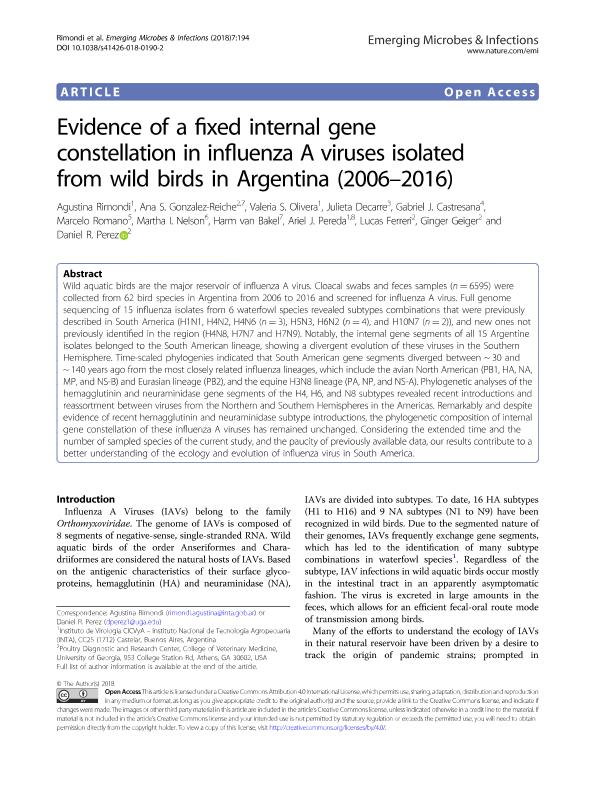Mostrar el registro sencillo del ítem
dc.contributor.author
Rimondi, Agustina

dc.contributor.author
Gonzalez Reiche, Ana S.
dc.contributor.author
Olivera, Valeria

dc.contributor.author
Decarre, Julieta

dc.contributor.author
Castresana, Gabriel J.
dc.contributor.author
Romano, Marcelo
dc.contributor.author
Nelson, Martha I.
dc.contributor.author
van Bakel, Harm
dc.contributor.author
Pereda, Ariel Julián

dc.contributor.author
Ferreri, Lucas

dc.contributor.author
Geiger, Ginger
dc.contributor.author
Perez, Daniel R.
dc.date.available
2020-04-17T16:07:38Z
dc.date.issued
2018-11
dc.identifier.citation
Rimondi, Agustina; Gonzalez Reiche, Ana S.; Olivera, Valeria; Decarre, Julieta; Castresana, Gabriel J.; et al.; Evidence of a fixed internal gene constellation in influenza A viruses isolated from wild birds in Argentina (2006–2016); Nature; Emerging Microbes & Infections; 7; 1; 11-2018; 1-13
dc.identifier.issn
2222-1751
dc.identifier.uri
http://hdl.handle.net/11336/102894
dc.description.abstract
Wild aquatic birds are the major reservoir of influenza A virus. Cloacal swabs and feces samples (n = 6595) were collected from 62 bird species in Argentina from 2006 to 2016 and screened for influenza A virus. Full genome sequencing of 15 influenza isolates from 6 waterfowl species revealed subtypes combinations that were previously described in South America (H1N1, H4N2, H4N6 (n = 3), H5N3, H6N2 (n = 4), and H10N7 (n = 2)), and new ones not previously identified in the region (H4N8, H7N7 and H7N9). Notably, the internal gene segments of all 15 Argentine isolates belonged to the South American lineage, showing a divergent evolution of these viruses in the Southern Hemisphere. Time-scaled phylogenies indicated that South American gene segments diverged between ~ 30 and~ 140 years ago from the most closely related influenza lineages, which include the avian North American (PB1, HA, NA, MP, and NS-B) and Eurasian lineage (PB2), and the equine H3N8 lineage (PA, NP, and NS-A). Phylogenetic analyses of the hemagglutinin and neuraminidase gene segments of the H4, H6, and N8 subtypes revealed recent introductions and reassortment between viruses from the Northern and Southern Hemispheres in the Americas. Remarkably and despite evidence of recent hemagglutinin and neuraminidase subtype introductions, the phylogenetic composition of internal gene constellation of these influenza A viruses has remained unchanged. Considering the extended time and the number of sampled species of the current study, and the paucity of previously available data, our results contribute to a better understanding of the ecology and evolution of influenza virus in South America.
dc.format
application/pdf
dc.language.iso
eng
dc.publisher
Nature

dc.rights
info:eu-repo/semantics/openAccess
dc.rights.uri
https://creativecommons.org/licenses/by-nc/2.5/ar/
dc.subject
INFLUENZA
dc.subject
ARGENTINA
dc.subject
EVOLUTION
dc.subject
ECOLOGY
dc.subject.classification
Virología

dc.subject.classification
Ciencias Biológicas

dc.subject.classification
CIENCIAS NATURALES Y EXACTAS

dc.title
Evidence of a fixed internal gene constellation in influenza A viruses isolated from wild birds in Argentina (2006–2016)
dc.type
info:eu-repo/semantics/article
dc.type
info:ar-repo/semantics/artículo
dc.type
info:eu-repo/semantics/publishedVersion
dc.date.updated
2020-03-13T13:34:34Z
dc.journal.volume
7
dc.journal.number
1
dc.journal.pagination
1-13
dc.journal.pais
China

dc.description.fil
Fil: Rimondi, Agustina. Instituto Nacional de Tecnología Agropecuaria. Centro de Investigación en Ciencias Veterinarias y Agronómicas. Instituto de Virología; Argentina. Consejo Nacional de Investigaciones Científicas y Técnicas; Argentina
dc.description.fil
Fil: Gonzalez Reiche, Ana S.. University of Georgia; Estados Unidos
dc.description.fil
Fil: Olivera, Valeria. Instituto Nacional de Tecnología Agropecuaria. Centro de Investigación en Ciencias Veterinarias y Agronómicas. Instituto de Virología; Argentina
dc.description.fil
Fil: Decarre, Julieta. Instituto Nacional de Tecnología Agropecuaria. Centro de Investigación de Recursos Naturales. Instituto de Recursos Biológicos; Argentina. Consejo Nacional de Investigaciones Científicas y Técnicas; Argentina
dc.description.fil
Fil: Castresana, Gabriel J.. Gobierno de la Provincia de Buenos Aires. Organismo Provincial Para El Desarrollo Sostenible.; Argentina
dc.description.fil
Fil: Romano, Marcelo. Centro de Investigaciones en Biodiversidad y Ambiente; Argentina
dc.description.fil
Fil: Nelson, Martha I.. National Institutes of Health; Estados Unidos
dc.description.fil
Fil: van Bakel, Harm. Icahn School of Medicine at Mount Sina; Estados Unidos
dc.description.fil
Fil: Pereda, Ariel Julián. Instituto Nacional de Tecnología Agropecuaria. Centro de Investigación en Ciencias Veterinarias y Agronómicas. Instituto de Virología; Argentina. Instituto Nacional de Tecnología Agropecuaria. Centro de Investigación en Ciencias Veterinarias y Agronómicas. Instituto de Patobiología; Argentina. Consejo Nacional de Investigaciones Científicas y Técnicas; Argentina
dc.description.fil
Fil: Ferreri, Lucas. Instituto Nacional de Tecnología Agropecuaria. Centro de Investigación en Ciencias Veterinarias y Agronómicas. Instituto de Virología; Argentina. Consejo Nacional de Investigaciones Científicas y Técnicas; Argentina. University of Georgia; Estados Unidos
dc.description.fil
Fil: Geiger, Ginger. University of Georgia; Estados Unidos
dc.description.fil
Fil: Perez, Daniel R.. University of Georgia; Estados Unidos
dc.journal.title
Emerging Microbes & Infections
dc.relation.alternativeid
info:eu-repo/semantics/altIdentifier/url/https://www.tandfonline.com/doi/full/10.1038/s41426-018-0190-2
dc.relation.alternativeid
info:eu-repo/semantics/altIdentifier/url/https://www.ncbi.nlm.nih.gov/pmc/articles/PMC6258671/
dc.relation.alternativeid
info:eu-repo/semantics/altIdentifier/doi/http://dx.doi.org/10.1038/s41426-018-0190-2
Archivos asociados
